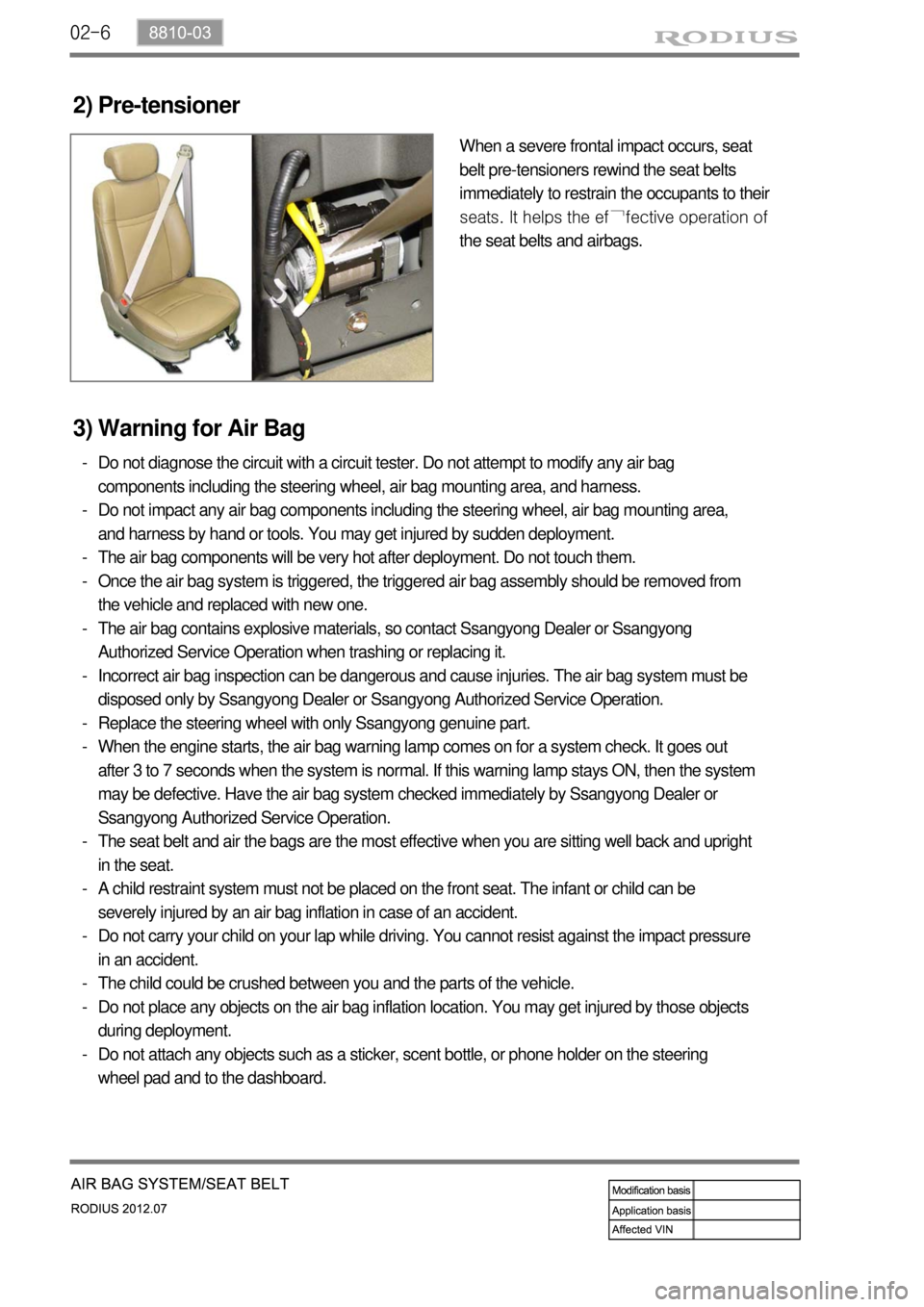engine SSANGYONG RODIUS 2012 Service Manual
[x] Cancel search | Manufacturer: SSANGYONG, Model Year: 2012, Model line: RODIUS, Model: SSANGYONG RODIUS 2012Pages: 715, PDF Size: 79.36 MB
Page 649 of 715

11-114610-00
Measure the oil pressure with the gauge valve
fully open. G.
Pressure at no load3 ~ 5bar
If the pump pressure is in specified range, the
pump is normal. If not, replace the power
steering pump H.
Turn the steering wheel righ or left until it
stops with the engine idling ans valve fully
open. I.
Oil pressure78 ~ 83bar
Page 657 of 715

01-2
Front air conditioner module assembly - inside instrument panel
Compressor - engine rightAQS/Air source selection
switch
Sun load sensor - instrument
panel upper left
1. SYSTEM LAYOUT AND COMPONENTS
Type Air cindotioner controller
FATC
Manual air
conditioner
It change sun load coming through
front windshield into current to input to
FATC controller. *
Air mix door
actuator
PTC (If equipped)
Duct temperature
sensor
Mode door
actuator
Air conditioner wiring
Thermo AMP
Air source door
actuator
Air conditioner
filter
Bloewr motor
Blower high speed relayPower transistor
Page 658 of 715

01-36810-30
Rear air conditioner module assembly - bottom of rear left
Engine ECU - passenger's
footstep
CondenserRecevier driver-condenser
right
Rear fan speed dial
Sub-condenser - right wheel
front
Absorbs moisture in the
refrigerant and reserves
refrigerant to supply
smoothly. *Instslled in front of vehicle and
condenses vapor refrigerant into
low temperature and high
pressure liquid refrigerant *
Condenses high temperature and
high pressure vapor refrigerant into
low-temperature-high-pressure
liquid refrigerant. *
Detects A/C AUTO switch position,
coolant temperature, engine
condition and driving condition to
control the air conditioner *
A sensor that detects coolant
temperature and transmits to
engine ECU *
Blower motor
Power transistor
Air conditoner high
pressure/low
pressure pipe
Air mix door
actuator
Front
Rear
A switch that controls the rear air
conditioner module. *
Collant temperature sensor -
on engine
Page 663 of 715

01-8
2. SYSTEM BLOCK DIAGRAM
A/C compressor OFF conditions ▶
Coolant temperature: over 115℃
Engine speed: over 4,500 rpm for more than 2 seconds
Engine speed: below 650 rpm
Maximum output due to abrupt acceleration
Excessive acceleration
Increased load during engine idling (to prevent the engine from shutting off)
Refrigerant pressure: over 32 bar or below 2 bar
Defects in A/C related system (refrigerant pressure sensor, coolant temperature sensor,
cooling fan) 1.
2.
3.
4.
5.
6.
7.
8.
Page 674 of 715

02-6
When a severe frontal impact occurs, seat
belt pre-tensioners rewind the seat belts
immediately to restrain the occupants to their
seats. It helps the ef¬fective operation of
the seat belts and airbags.
2) Pre-tensioner
3) Warning for Air Bag
Do not diagnose the circuit with a circuit tester. Do not attempt to modify any air bag
components including the steering wheel, air bag mounting area, and harness.
Do not impact any air bag components including the steering wheel, air bag mounting area,
and harness by hand or tools. You may get injured by sudden deployment.
The air bag components will be very hot after deployment. Do not touch them.
Once the air bag system is triggered, the triggered air bag assembly should be removed from
the vehicle and replaced with new one.
The air bag contains explosive materials, so contact Ssangyong Dealer or Ssangyong
Authorized Service Operation when trashing or replacing it.
Incorrect air bag inspection can be dangerous and cause injuries. The air bag system must be
disposed only by Ssangyong Dealer or Ssangyong Authorized Service Operation.
Replace the steering wheel with only Ssangyong genuine part.
When the engine starts, the air bag warning lamp comes on for a system check. It goes out
after 3 to 7 seconds when the system is normal. If this warning lamp stays ON, then the system
may be defective. Have the air bag system checked immediately by Ssangyong Dealer or
Ssangyong Authorized Service Operation.
The seat belt and air the bags are the most effective when you are sitting well back and upright
in the seat.
A child restraint system must not be placed on the front seat. The infant or child can be
severely injured by an air bag inflation in case of an accident.
Do not carry your child on your lap while driving. You cannot resist against the impact pressure
in an accident.
The child could be crushed between you and the parts of the vehicle.
Do not place any objects on the air bag inflation location. You may get injured by those objects
during deployment.
Do not attach any objects such as a sticker, scent bottle, or phone holder on the steering
wheel pad and to the dashboard. -
-
-
-
-
-
-
-
-
-
-
-
-
-